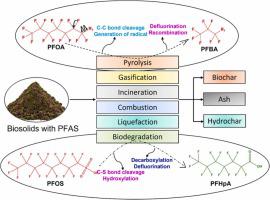Journal of Hazardous Materials ( IF 12.2 ) Pub Date : 2023-03-15 , DOI: 10.1016/j.jhazmat.2023.131212 Ravinder Kumar 1 , Tewodros Kassa Dada 1 , Anna Whelan 2 , Patrick Cannon 3 , Madoc Sheehan 1 , Louise Reeves 4 , Elsa Antunes 1

|
Per- and polyfluoroalkyl substances (PFAS) are persistent organic chemicals detected in biosolids worldwide, which have become a significant concern for biosolids applications due to their increasing environmental risks. Hence, it is pivotal to understand the magnitude of PFAS contamination in biosolids and implement effective technologies to reduce their contamination and prevent hazardous aftermaths. Thermal techniques such as pyrolysis, incineration and gasification, and biodegradation have been regarded as impactful solutions to degrade PFAS and transform biosolids into value-added products like biochar. These techniques can mineralize PFAS compounds under specific operating parameters, which can lead to unique degradation mechanisms and pathways. Understanding PFAS degradation mechanisms can pave the way to design the technology and to optimize the process conditions. Therefore, in this review, we aim to review and compare PFAS degradation mechanisms in thermal treatment like pyrolysis, incineration, gasification, smouldering combustion, hydrothermal liquefaction (HTL), and biodegradation. For instance, in biodegradation of perfluorooctane sulfonic acid (PFOS), firstly bond cleavage occurs which is followed by hydroxylation, decarboxylation and defluorination reactions to form perfluoroheptanoic acid. In HTL, PFOS degradation is carried through catalyzed series of nucleophilic substitution and decarboxylation reactions. In contrast, thermal PFOS degradation involves a three-step random-chain scission pathway. The first step includes bond cleavage, followed by defluorination of perfluoroalkyl radical, and radical chain propagation reactions. Finally, the termination of chain propagation reactions produces very short-fluorinated units. We also highlighted important policies and strategies employed worldwide to curb PFAS contamination in biosolids.
中文翻译:

生物固体中 PFAS 降解的微生物和热处理技术:关注降解机制和途径
全氟和多氟烷基物质 (PFAS) 是在全球范围内的生物固体中检测到的持久性有机化学物质,由于其日益增加的环境风险,它们已成为生物固体应用的一个重要问题。因此,了解生物固体中 PFAS 污染的程度并实施有效技术以减少其污染和防止危险后果至关重要。热解、焚烧和气化以及生物降解等热技术被认为是降解 PFAS 并将生物固体转化为生物炭等增值产品的有效解决方案。这些技术可以在特定操作参数下矿化 PFAS 化合物,从而产生独特的降解机制和途径。了解 PFAS 降解机制可以为设计技术和优化工艺条件铺平道路。因此,在这篇综述中,我们旨在回顾和比较 PFAS 在热解、焚烧、气化、阴燃燃烧、水热液化 (HTL) 和生物降解等热处理中的降解机制。例如,在全氟辛烷磺酸(PFOS)的生物降解中,首先发生键断裂,随后发生羟基化、脱羧和脱氟反应,形成全氟庚酸。在 HTL 中,PFOS 的降解是通过催化一系列亲核取代和脱羧反应。相反,全氟辛烷磺酸热降解涉及三步随机链断裂途径。第一步包括键断裂,然后是全氟烷基自由基的脱氟和自由基链增长反应。最后,链增长反应的终止产生非常短的氟化单元。我们还强调了全球采用的重要政策和战略,以遏制生物固体中的 PFAS 污染。











































 京公网安备 11010802027423号
京公网安备 11010802027423号